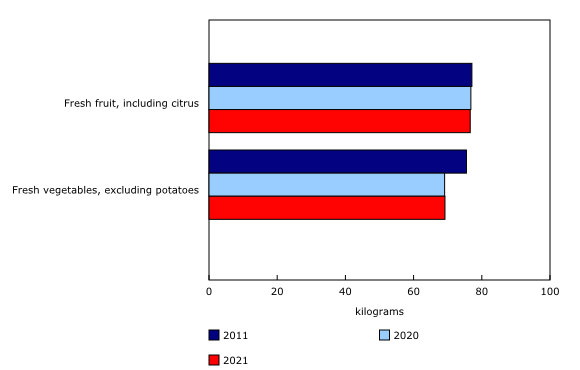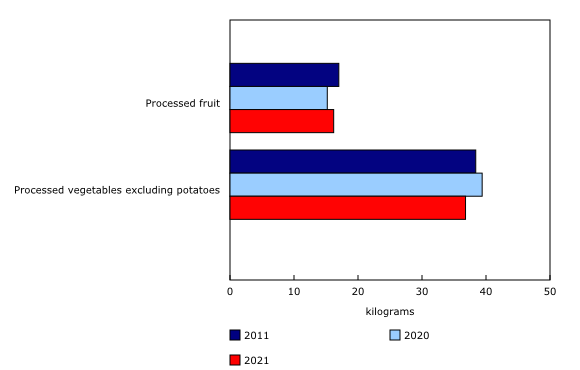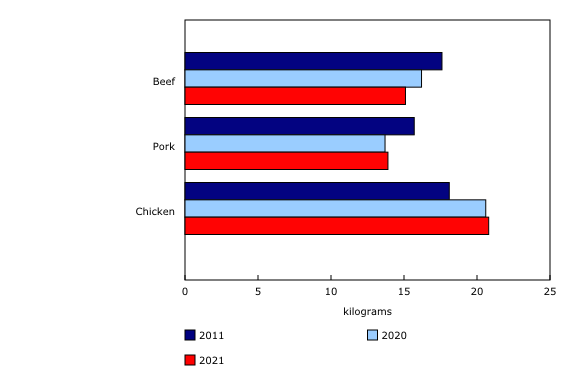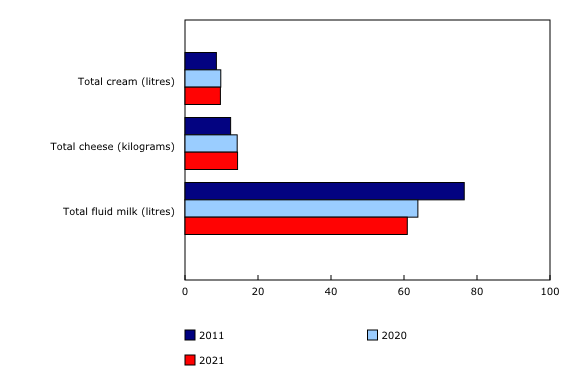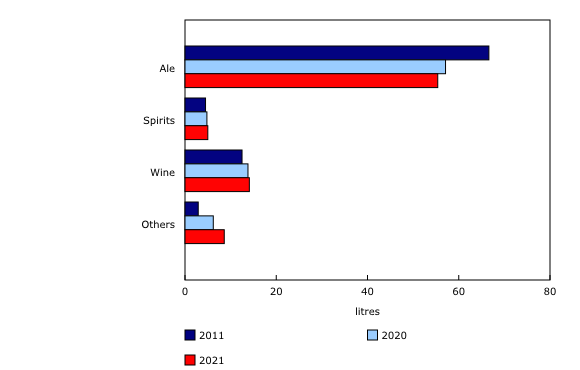Food availability, 2021
Released: 2022-05-31
The COVID-19 pandemic has contributed to many challenges for the food supply chain over the past two years, including temporary shutdowns, limitations on international trade and disruptions to transportation routes.
Food availability indicates the amount of food that is physically present in a country for consumption. It does not measure demand nor food consumption. Comparisons over time can reflect shifts in Canadian consumer preferences.
The food availability series also provides an overview of supply and disposition of food in Canada, including annual measures of domestic production, international trade and manufacturing.
Over the course of 2021, supply chain issues continued to influence consumer behaviour. As a result, the relationship between food availability and consumer preference was more difficult to discern on an annual basis. However, food availability statistics for certain commodities showed some return to pre-pandemic levels, notably chicken production, which fell for the first time in over a decade in 2020.
Decline in fresh and processed fruit and vegetable availability over the past 10 years
The availability of fresh fruits, including citrus, was relatively stable (-0.2%) from 2020, with fresh fruit production declining by 5.3% and imports rising by 2.6%. The total amount of fresh fruit available declined slightly (-0.6%) from a decade earlier to 76.6 kilograms per person in 2021. Fresh fruit production (+7.1%) and imports (+12.4%) increased from 2011. However, Canada's population growth outpaced these increases, yielding lower per capita availability.
The total amount of processed fruit available for consumption increased 8.4% annually to 16.3 kilograms of fresh equivalent fruit per person in 2021, which remained 4.3% lower than in 2011. When compared with 2020, the availability of total frozen fruits (+24.6%) and canned fruits (+6.1%) were both up, while the availability of dried fruits declined by 5.1%.
The total amount of fresh vegetables available for consumption, excluding potatoes, edged up (+0.2%) from the previous year to 69.2 kilograms per person in 2021, though this was down 8.3% from a decade earlier.
Total processed vegetables, excluding potatoes, which includes frozen and canned vegetables available for consumption (fresh equivalent weight), decreased 6.7% from 2020 to 36.8 kilograms per person in 2021, and was 4.0% lower than in 2011. The total amount of frozen vegetables (fresh equivalent weight) decreased 6.0% compared with 2020 to 8.0 kilograms per person in 2021, and was up 4.0% from a decade earlier.
Chicken continues to lead meat availability for thirteenth straight year
The availability of total poultry for consumption (including chicken, turkey and stewing hens) declined slightly (-0.3%) on an annual basis to 25.1 kilograms of boneless weight per person in 2021, but increased 9.4% from 2011.
Poultry production rebounded (+1.4%) from 2020 after the pandemic caused the first decline in Canadian poultry production since 2009. This suggests that the poultry industry may have recovered from temporary shutdowns and interruptions to the supply chain that occurred in 2020. Chicken available for consumption edged up by 0.7% from 2020 to 20.8 kilograms per person in 2021.
Red meat available for consumption declined 3.4% annually to 31.1 kilograms of boneless weight per person in 2021, mainly because of lower beef availability (-7.1%, to 15.1 kilograms of boneless weight per person), as a result of record exports spurred on by strong demand for Canadian beef (especially from the United States). In comparison with 2011, beef availability was down 14.1% in 2021.
Conversely, pork availability increased slightly (+1.2%) from a year earlier at 13.9 kilograms of boneless weight per person, but was down 11.6% from 2011.
Egg availability for consumption increases despite higher egg exports
The amount of eggs available for consumption increased by 0.7% from the previous year to 21.4 dozens per person in 2021. This amounts to an increase of 26.9% from a decade earlier.
Total egg production rose 1.1% from 2020 to 848.2 million dozens in 2021, and was up 31.6% when compared with 2011. Imports of eggs increased 15.4% from a year earlier, which amounts to nearly a two-fold increase (+97.0%) from 2011. On the other hand, while egg exports increased by 34.1% when compared with 2020, they were down 43.0% from a decade earlier.
Total cheese and cream availability continues to increase, while total fluid milk availability declines
The amount of total milk available for consumption decreased 4.5% from a year earlier to 60.9 litres per person in 2021. The drop in production of skim milk (-53.8%), 1% milk (-32.2%) and chocolate milk (-15.8%) over the past decade contributed to a decline in total milk availability by 20.3% when compared with 2011.
Conversely, the availability of total cheese increased 15.1% from 2011 to 14.4 kilograms per person in 2021. Production and imports of cheddar cheese and variety cheeses were both up from a decade earlier, while the availability of processed cheese was down 9.0%.
The availability of all cream, including table cream, sour cream, whipping cream and cereal cream, was down (-0.6%) in 2021 from the year before to 9.7 litres per person. This remains 12.3% higher than in 2011. Conversely, ice cream availability was down 10.6% from 2020, and down 6.2% from a decade earlier.
Availability of wheat flour and breakfast food decreases in 2021
Wheat flour available for consumption decreased 4.4% from 2020 to 57.7 kilograms per person in 2021, and remained 4.8% below 2011 levels. This decrease coincides with a decline in wheat production as a result of drought conditions in western Canada.
Breakfast food availability, which includes hot and cold cereals, was also down (-8.3%) when compared with 2020 and was 18.0% lower than a decade earlier.
Maple sugar availability declines in 2021
Maple sugar available for consumption declined by 10.1% annually to 0.5 kilograms per person in 2021 because of a decline in production (-20.9%) and an increase in exports (20.7%). A short maple season yielded lower production because of warm spring temperatures. Despite the decline in 2021, maple sugar availability remained more than twice as high as it was a decade earlier (+134.5%).
Refined sugar availability decreased 6.9% from the previous year to 28.6 kilograms per person because of higher exports (+7.4%) and lower imports (-9.3%). Although refined sugar availability was down (-5.9%) when compared with 2011, production (+19.7%) and exports (+24.7%) remained strong.
The availability of honey was up 15.7% compared with 2020 to 1.1 kilograms per person in 2021, spurred by higher production (+7.9%) and imports (+14.8%) and lower exports (-20.1%). This amounts to an increase of 24.6% when compared with 2011.
Availability for juices increase, while soft drinks continue to decline
The availability of juice has been in decline for the better part of 20 years, possibly as a result of consumers shifting away from more sugary drinks to healthier options. The availability of total juice increased for the first time in a decade in 2021 (+2.2%). However it remained 20.4% lower when compared with 2011.
Soft drink availability was down 3.4% from 2020 to 50.9 litres per person in 2021, and was over one-third (-39.2%) lower compared with 2011. The continuing decline in soft drink availability was also likely because of consumers choosing drinks that contain less sugar.
Ale availability declines, while wine, ciders, coolers and other refreshment beverages rise
Because alcohol data are reported by fiscal year (April to March) based on the sales volume of alcohol beverages, this year's release covers the availability of alcohol during the first full year of the pandemic (April 2020 to March 2021).
The availability of ale declined 2.9% on an annual basis to 55.4 litres per person in 2020/2021, and was down 16.7% from 2010/2011.
Wine availability increased 1.5% compared with 2019/2020 to 14.1 litres per person. Availabilities of wine (+12.8%), spirits (+11.0%) and ciders, coolers and other refreshment beverages (+202.9%) were all up from 2010/2011.
Note to readers
Data on food availability per person for select products and on the supply and disposition of these products are now available for 2021.
Data presented in this release are compiled from a wide variety of sources, both survey and administrative, from within Statistics Canada, as well as from other sources, including provincial and federal government departments, growers' associations, and marketing boards.
The food availability data series is the result of a partnership between Agriculture and Agri-Food Canada and Statistics Canada.
For the latest information on the Census of Agriculture, visit the Census of Agriculture portal.
For more information on agriculture and food, visit the Agriculture and food statistics portal.
Contact information
For more information, or to enquire about the concepts, methods or data quality of this release, contact us (toll-free 1-800-263-1136; 514-283-8300; infostats@statcan.gc.ca) or Media Relations (statcan.mediahotline-ligneinfomedias.statcan@statcan.gc.ca).
- Date modified:

